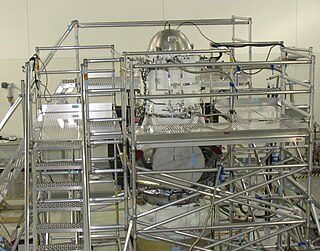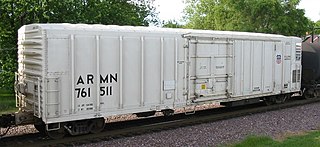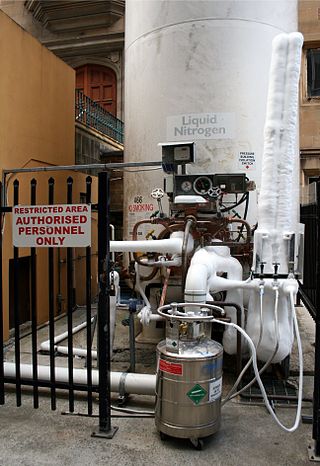Related Research Articles

In physics, cryogenics is the production and behaviour of materials at very low temperatures.

Sir James Dewar was a British chemist and physicist. He is best known for his invention of the vacuum flask, which he used in conjunction with research into the liquefaction of gases. He also studied atomic and molecular spectroscopy, working in these fields for more than 25 years.

Liquid hydrogen (H2(l)) is the liquid state of the element hydrogen. Hydrogen is found naturally in the molecular H2 form.
The following is a timeline of low-temperature technology and cryogenic technology. It also lists important milestones in thermometry, thermodynamics, statistical physics and calorimetry, that were crucial in development of low temperature systems.

A vacuum flask is an insulating storage vessel that greatly lengthens the time over which its contents remain hotter or cooler than the flask's surroundings. Invented by Sir James Dewar in 1892, the vacuum flask consists of two flasks, placed one within the other and joined at the neck. The gap between the two flasks is partially evacuated of air, creating a near-vacuum which significantly reduces heat transfer by conduction or convection. When used to hold cold liquids, this also virtually eliminates condensation on the outside of the flask.
A cryopump or a "cryogenic pump" is a vacuum pump that traps gases and vapours by condensing them on a cold surface, but are only effective on some gases. The effectiveness depends on the freezing and boiling points of the gas relative to the cryopump's temperature. They are sometimes used to block particular contaminants, for example in front of a diffusion pump to trap backstreaming oil, or in front of a McLeod gauge to keep out water. In this function, they are called a cryotrap, waterpump or cold trap, even though the physical mechanism is the same as for a cryopump.

A 3He/4He dilution refrigerator is a cryogenic device that provides continuous cooling to temperatures as low as 2 mK, with no moving parts in the low-temperature region. The cooling power is provided by the heat of mixing of the helium-3 and helium-4 isotopes.
Natural-gas condensate, also called natural gas liquids, is a low-density mixture of hydrocarbon liquids that are present as gaseous components in the raw natural gas produced from many natural gas fields. Some gas species within the raw natural gas will condense to a liquid state if the temperature is reduced to below the hydrocarbon dew point temperature at a set pressure.

A cryostat is a device used to maintain low cryogenic temperatures of samples or devices mounted within the cryostat. Low temperatures may be maintained within a cryostat by using various refrigeration methods, most commonly using cryogenic fluid bath such as liquid helium. Hence it is usually assembled into a vessel, similar in construction to a vacuum flask or Dewar. Cryostats have numerous applications within science, engineering, and medicine.

A refrigerator car is a refrigerated boxcar (U.S.), a piece of railroad rolling stock designed to carry perishable freight at specific temperatures. Refrigerator cars differ from simple insulated boxcars and ventilated boxcars, neither of which are fitted with cooling apparatus. Reefers can be ice-cooled, come equipped with any one of a variety of mechanical refrigeration systems, or utilize carbon dioxide as a cooling agent. Milk cars may or may not include a cooling system, but are equipped with high-speed trucks and other modifications that allow them to travel with passenger trains.

A keg is a small barrel.

An icemaker, ice generator, or ice machine may refer to either a consumer device for making ice, found inside a home freezer; a stand-alone appliance for making ice, or an industrial machine for making ice on a large scale. The term "ice machine" usually refers to the stand-alone appliance.

Icyball is a name given to two early refrigerators, one made by Australian Sir Edward Hallstrom in 1923, and the other design patented by David Forbes Keith of Toronto, and manufactured by American Powel Crosley Jr., who bought the rights to the device. Both devices are unusual in design in that they did not require the use of electricity for cooling. They can run for a day on a cup of kerosene, allowing rural users lacking electricity the benefits of refrigeration.

An absorption refrigerator is a refrigerator that uses a heat source to provide the energy needed to drive the cooling process. The system uses two coolants, the first of which performs evaporative cooling and is then absorbed into the second coolant; heat is needed to reset the two coolants to their initial states. The principle can also be used to air-condition buildings using the waste heat from a gas turbine or water heater. Using waste heat from a gas turbine makes the turbine very efficient because it first produces electricity, then hot water, and finally, air-conditioning—trigeneration. Absorption refrigerators are commonly used in recreational vehicles (RVs), campers, and caravans because the heat required to power them can be provided by a propane fuel burner, by a low-voltage DC electric heater or by a mains-powered electric heater. Unlike more common vapor-compression refrigeration systems, an absorption refrigerator has no moving parts.
The sorption pump is a vacuum pump that creates a vacuum by adsorbing molecules on a very porous material like molecular sieve which is cooled by a cryogen, typically liquid nitrogen. The ultimate pressure is about 10−2 mbar. With special techniques this can be lowered till 10−7 mbar. The main advantages are the absence of oil or other contaminants, low cost and vibration free operation because there are no moving parts. The main disadvantages are that it cannot operate continuously and cannot effectively pump hydrogen, helium and neon, all gases with lower condensation temperature than liquid nitrogen. The main application is as a roughing pump for a sputter-ion pump in ultra-high vacuum experiments, for example in surface physics.

Vapour-compression refrigeration or vapor-compression refrigeration system (VCRS), in which the refrigerant undergoes phase changes, is one of the many refrigeration cycles and is the most widely used method for air conditioning of buildings and automobiles. It is also used in domestic and commercial refrigerators, large-scale warehouses for chilled or frozen storage of foods and meats, refrigerated trucks and railroad cars, and a host of other commercial and industrial services. Oil refineries, petrochemical and chemical processing plants, and natural gas processing plants are among the many types of industrial plants that often utilize large vapor-compression refrigeration systems. Cascade refrigeration systems may also be implemented using two compressors.

An evaporator is a device used to turn a liquid into a gas.

A refrigerator truck or chiller lorry, is a van or truck designed to carry perishable freight at low temperatures. Most long-distance refrigerated transport by truck is done in articulated trucks pulling refrigerated hardside (box) semi-trailers, although insulated curtainsiders are common in some countries. Occasionally, refrigerated trailers have been used as temporary morgues, and second-hand refrigerated trailers are frequently sold for use in tiny home conversions due to their insulation and existing status as a vehicle.
A liquid hydrogen tank car, also called liquid hydrogen tank wagon or liquid hydrogen tanker wagon is a railroad tank car designed to carry cryogenic liquid hydrogen (LH2). LH2 tank cars with a capacity of 17,000 pounds (7,711 kg) are used for transcontinental transport.

A cryogenic storage dewar is a specialised type of vacuum flask used for storing cryogens, whose boiling points are much lower than room temperature. Cryogenic storage dewars may take several different forms including open buckets, flasks with loose-fitting stoppers and self-pressurising tanks. All dewars have walls constructed from two or more layers, with a high vacuum maintained between the layers. This provides very good thermal insulation between the interior and exterior of the dewar, which reduces the rate at which the contents boil away. Precautions are taken in the design of dewars to safely manage the gas which is released as the liquid slowly boils. The simplest dewars allow the gas to escape either through an open top or past a loose-fitting stopper to prevent the risk of explosion. More sophisticated dewars trap the gas above the liquid, and hold it at high pressure. This increases the boiling point of the liquid, allowing it to be stored for extended periods. Excessive vapour pressure is released automatically through safety valves. The method of decanting liquid from a dewar depends upon its design. Simple dewars may be tilted, to pour liquid from the neck. Self-pressurising designs use the pressure of the gas in the top of the dewar to force the liquid upward through a pipe leading to the neck.